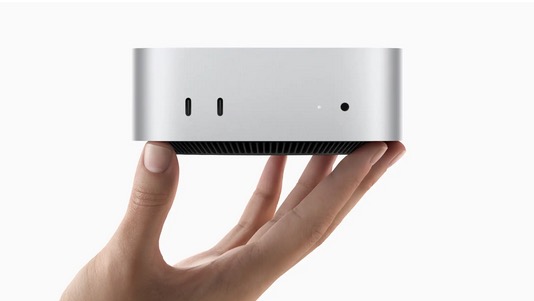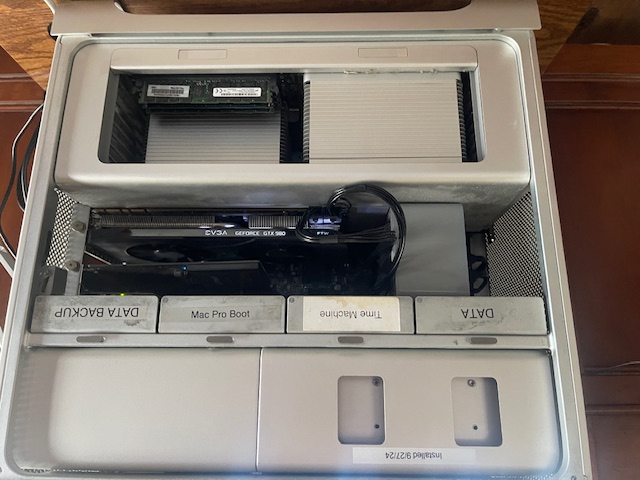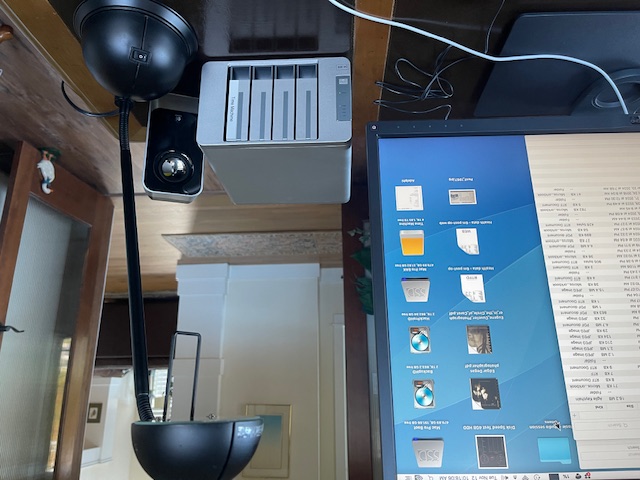Time to move on.

Tiny.
Upate six months later:. For an update after 6 months of daily use, click here.
Apple’s planned obsolesence strategy has seen to it that my 2010 Mac Pro, a machine as reliable as a hammer, is now no fewer than six generations of OS out of date. That means that those nasty Russkie hackers can have at it to their hearts’ content and next thing you know my credit card will have run up $10mm in charges for caviar and vodka and yours truly will be out on the street.
But a strange thing happened. Apple just released the minuscule Mac Mini M4 at what can only be called a bargain price by Apple’s gouging standards, starting at $600 for the 16GB/256GB model. I paid Amazon $745 for the 16GB/512GB slightly upgraded version as I need a larger SSD to store all my applications and the 80GB of Lightroom preview files which load quickly from the SSD. (The picture files, much larger, reside on a slow, spinning disk drive, where speed is not required).
My Mac Mini M4 arrives tonight and because I will need to move the disk drives from the innards of the Mac Pro I had to procure an external drive enclosure as well as an enclosure for the BluRay DVD reader/writer. Along with a handful of cables the bill came to $1,000, one quarter of the investment in the significantly upgraded Mac Pro.
After doing some reading I have determined that the safest and fastest way to migrate apps from the Mac Pro is to use the Time Machine (sequential) back-up (using Migration Utility) which I always have running in the MP.
While the wi-fi here is fast and reliable I am going for a wired connection of the TM HDD to the new Mini. Wired connections do not go down.
So first I removed the TM HDD from the gorgeous MP (boy am I going to miss that machine). Here it is, all 54 lbs of it, as perfect an industrial design as Apple conceived, and actually Jony Ive’s first major effort at Apple, before he became obsessed with smallness and thinness to the detriment of ergonomics. 5 large fans plus 2 in the GPU, two 3.46GHz 6 core Intel CPUs, Blu Ray DVD, USB3 upgrade, super Nvidia 980GTX GPU and all of 80GB of RAM:

Not tiny.
The new Terramaster disk drive box:

Terramaster drive enclosure.
The other three bays will hold a 512GB SSD to back-up the Mini’s OS and applications, the main Data drive (a 2TB HDD – don’t need speed there) and another 2TB back-up Data drive. The OS/apps and Data drives are automatically cloned daily using Carbon Copy Cloner. Time Machine runs on its own schedule. I copy the photos to an SSD in my car monthly for ‘belt and suspenders’ safety. Of course, should both the home and garage burn down ….
All my photos and documents reside on the Data drive. The Terramaster is nicely made, the drives (either 3.5” or 2.5”) are easily installed, and it has two large and silent cooling fans. It will eventually be moved into the footwell of my desk, out of sight. It’s USB 3.1, so fairly speedy. Even though SSDs are now affordable I really do not need the speed and the old HDDs continue working well at no added cost. I will simply hard wire the Terramaster (USB-C) to the new Mini and have at it for migration.
Next I will remove the BluRay DVD reader/writer from the MP and install it in an OWC separate stand-alone enclosure. One of the nice things about the old MP is that all major peripherals are stored inside the enclosure. No more.
A major issue will be whether my (ancient) versions of Lightroom and Photoshop can have their perpetual licenses transferred from the MP to the Mini. The web is all over the place on this. Adobe is a very low integrity business so I may be finally forced into their subscription model – $38/mth for LR and PS. The advantage is that those latest versions are optimized for the Apple M series CPUs, meaning they run faster, and as we know LR is a real bear. Plus the apps have been significantly enhanced since my 9 year and 12 year old versions. The disadvantage is $456/year and the revolting thought of sending Adobe money, however modest the sum.
The Kensington keyboard (I cannot stand Apple’s designs), Logitech mouse (ditto – the Apple mouse is an ergonomic disaster – what idiot placed the charging port on the underside of this already horrible design?), and Logitech speakers (the Mini has a coaxial socket for those), along with the BenQ monitor, all hard wired, will carry over to the Mini. I had to procure a bunch of USB-A to USB-C adapters because USB-C is all the Mini offers. As the monitor will be connected to the Mini using HDMI, whereas the Mac Pro uses Display Port, I can have both computers connected to the monitor during the conversion period and simply switch inputs when needed. Nice.
More in the next article as I contemplate the horrors of migration.